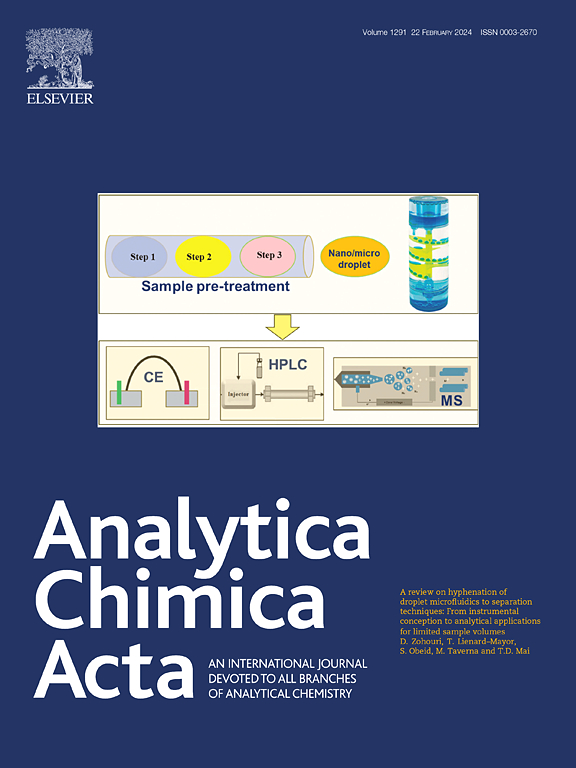一种用于同时检测极性、粘度和酯酶的单荧光探针
IF 5.7
2区 化学
Q1 CHEMISTRY, ANALYTICAL
引用次数: 0
摘要
背景:酯酶活性和物理化学微环境(如极性和黏度)之间的动态相互作用对于解码细胞凋亡、铁凋亡和药物毒性等过程中的早期细胞功能障碍至关重要。然而,传统的探针通常只报告一个参数,模糊了酶活性和膜性质的相互依赖的变化。这种技术差距限制了我们在亚细胞区室中捕捉实时、空间分辨波动的能力。开发一种多功能、双发射探针,同时监测酯酶活性、极性和粘度,从而为复杂的病理生理机制提供前所未有的见解,并提高诊断精度。结果我们提出了一种双靶向荧光探针PQE,该探针通过线粒体定位的红色荧光(λex/em = 490/630 nm)和脂滴固定的绿色荧光(λex/em = 405/525 nm)同时监测活细胞中的酯酶活性、极性和粘度。PQE集成了三个功能模块:一个基于喹啉的极性传感器,在溶剂极性Δƒ从0.0205到0.3200之间显示48倍的荧光衰减;一个芘衍生的分子转子,在0.89到965 cP的粘度范围内显示50倍的荧光增强;一个乙酰氧基甲基(AcOM)酯酶激活基团,在水解后显示39倍的荧光增强。使用PQE,我们区分了活细胞、早期凋亡细胞和固定细胞,并观察到铁致酯酶失活与线粒体粘度增加和脂滴极性降低相吻合。此外,PQE还动态可视化了对乙酰氨基酚和脂多糖诱导的肝毒性模型中的酯酶抑制和粘极性失衡。与单参数检测相比,在单个探针中同时监测多个标记物可以在相同的细胞环境中全面分析酶活性、粘度和极性。这种实时的、细胞器特异性的方法提高了检测铁致坏死和肝毒性事件的灵敏度和准确性,并可能加速在诊断和药物筛选中的应用。本文章由计算机程序翻译,如有差异,请以英文原文为准。

A Single Fluorescent Probe for Simultaneous Detection of Polarity, Viscosity, and Esterase
Background
The dynamic interplay between esterase activity and physicochemical microenvironments—such as polarity and viscosity—is critical for decoding early cellular dysfunction in processes like apoptosis, ferroptosis, and drug-induced toxicity. However, conventional probes typically report only a single parameter, obscuring interdependent changes in enzyme activity and membrane properties. This technological gap limits our ability to capture real-time, spatially resolved fluctuations within subcellular compartments. Developing a multifunctional, dual-emission probe that concurrently monitors esterase activity, polarity, and viscosity would thus provide unprecedented insight into complex pathophysiological mechanisms and enhance diagnostic precision.Results
We propose a dual-targeted fluorescent probe PQE, which achieves simultaneous monitoring of esterase activity, polarity and viscosity in living cells through mitochondria-localized red fluorescence (λex/em = 490/630 nm) and lipid droplet-anchored green fluorescence (λex/em = 405/525 nm). PQE integrates three functional modules: a quinoline-based polarity sensor exhibiting 48-fold fluorescence attenuation across solvent polarity Δƒ from 0.0205 to 0.3200, a pyrene-derived molecular rotor showing 50-fold fluorescence enhancement over a viscosity range of 0.89 to 965 cP, and an acetoxymethyl (AcOM) esterase-activatable group demonstrating 39-fold fluorescence increase after hydrolysis. Using PQE, we distinguished live cells, early apoptotic cells, and fixed cells, and observed that ferroptosis-induced esterase inactivation coincided with increased mitochondrial viscosity and decreased lipid droplet polarity. In addition, PQE also dynamically visualized esterase inhibition and viscosity-polarity imbalance in acetaminophen and LPS-induced hepatotoxicity models.Significance
Compared to single-parameter detection, the simultaneous monitoring of multiple markers in a single probe enables comprehensive profiling of enzymatic activity, viscosity, and polarity within the same cellular context. This real-time, organelle-specific approach enhances sensitivity and accuracy in detecting ferroptotic, hepatotoxic events and may accelerate applications in diagnostics and drug screening.求助全文
通过发布文献求助,成功后即可免费获取论文全文。
去求助
来源期刊

Analytica Chimica Acta
化学-分析化学
CiteScore
10.40
自引率
6.50%
发文量
1081
审稿时长
38 days
期刊介绍:
Analytica Chimica Acta has an open access mirror journal Analytica Chimica Acta: X, sharing the same aims and scope, editorial team, submission system and rigorous peer review.
Analytica Chimica Acta provides a forum for the rapid publication of original research, and critical, comprehensive reviews dealing with all aspects of fundamental and applied modern analytical chemistry. The journal welcomes the submission of research papers which report studies concerning the development of new and significant analytical methodologies. In determining the suitability of submitted articles for publication, particular scrutiny will be placed on the degree of novelty and impact of the research and the extent to which it adds to the existing body of knowledge in analytical chemistry.
 求助内容:
求助内容: 应助结果提醒方式:
应助结果提醒方式:


